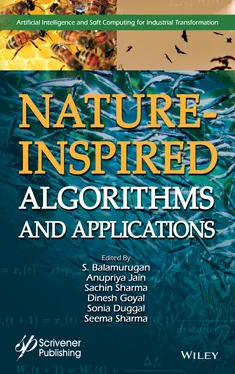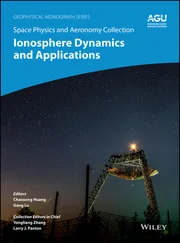1.5.1.4.9 Artificial Bee Colony Algorithm
ABC algorithm is one of the algorithms based on optimization of the hunting behavior of swarm and honey bee introduced by Dervis Karaboga. This was inspired by hunting behavior of honey bees. The algorithm is explicitly constructed on the model introduced by Tereshko and Loengarov in 2005 for the hunting behavior in colonies of honey bee. These approaches consist of three basic segments: food sources, employed, and unemployed. The employed and unemployed segments do the process of searching food resources and the other segment will be close to the hive. The classical model also referred as two dynamic methods of conducting is indispensable for self-organizing and aggregates knowledge that conscription of hunters to food resources is bringing about positive criticism and neglecting poor resources by hunters, causing negative input.
In ABC, settlements of agent like artificial forager bees scan for rich food a resource that is the great answers for a given problem. ABC is applied for the consideration problem of optimization that is initially changed over to the problem of identifying the finest constraint vector that limits a goal work. Artificial bees iteratively identify a populace of beginning planned vectors, and afterward, the process of iteration is improved by them and utilizes the systems as moving toward better arrangements by methods for a neighbor search instrument while neglecting deprived solution [9].
ABC algorithm is based on populace, and the situation of a food resource characterize to a potential solution for the problem of optimization and the measure of nectar in the food resource compared with the eminence of wellness of the solution are related. The utilization amount of honey bees is corresponding with the amount of activities in the general population. Initially, an arbitrarily conveyed beginning populace as food resource positions is produced. After initialization, the general population is unprotected to rehash the patterns in searching actions of the scout bees, unemployed bees, and employed bees separately. The employed honey bee delivers with an alteration on the location of source in the memory of bee and identifies other nourishment location of source. The nectar measure is the upgraded one with maximum of the source, and the honey bee has the ability to recollect the new position of the location and superintend the anterior one, or the situation is kept the memory. Totally employed honey bees complete the quest technique, and then, they share the position of the data sources along with the spectators that move in the region. The onlooker honey bee considers the nectar taken from employed honey bee and afterward preferences a nourishment source contingent upon the nectar measures of sources. As on account of the employed honey bee, they deliver an adjustment on the source of the location in memory of bee and form its nectar quantity. The nectar which has the maximum than that of the past one is collected and the honey bee retains the new location and supervises the anterior one. The sources of location that is relinquished are determined, and new location of sources is arbitrarily transported to be changed along with the unrestricted ones by artificial bee of scouts.
The applications of the ABC algorithm are used in the problem of medical pattern classification, network reconfiguration, minimum spanning tree, train neural networks, radial distribution system of network reconfiguration, and train neural networks.
1.5.1.4.10 River Formation Dynamics
River Formation Dynamic (RFD) is an optimization approach based on heuristic method on the behavior of manner in which the water is dropped from river bed. This mimicks how river water, by decomposition of the ground, saves the silt. The group of droplets that are placed at the beginning stage is exposed to force by gravitation that pulls in the drops to the focal point of the earth. The results of these drops are circulated all through their condition and looking for the absolute bottom in the ocean. Numerous new riverbeds are framed in the process right now. The RFD uses the idea behind the problems of graph theory. The group of drops by agents is made and proceeds onward edges between hubs that investigating a domain for the best arrangement. This is cultivated by components of disintegration and top soil sedimentation that identify with changes in the height that is consigned to every other hub. Drops while transferring to all through a situation of alter hub heights along their way. The change starting with one hub then onto the next is completed by diminishing height of the hubs, which in certainty gives numerous advantages like local cycles that are avoided. When drops change the site by minimum or maximum of the height of spots, the explanations are given by the path of height which is diminishing. Minimizing angles are constructed and the inclines are lag behind the consequent droplets as to create the fresh directions and strengthen the finest direction. This optimization of heuristic approach is introduced by Rabanalin 2007. RFD is utilized to solve TSP.
The working of RFD algorithm is as follows. A measure of soil is allotted to every hub. Drops, as they move, disintegrate their ways like taking some dirt from hubs or storing the conveyed dregs, which is referred, in this way, as expanding the elevations of hubs. Probability of selecting the following hub relies upon the slope which is corresponding to the contrast between tallness of the hub at which the drop lives and stature of its neighbor. Initially, the earth is level, for example, heights of all centers are corresponding, and aside from the objective center which is equivalent to zero during the whole procedure. Drops are put in the underlying center to empower further investigation of the earth. At each stage, a gathering of drops consecutively navigates the space and afterward performs disintegration on visited hubs [11].
The RFD algorithm has some disadvantages which avoid the algorithm for great execution, termed as problem of path generation. On account of an enormous number of coefficients, tuning of the algorithm to a specific case which is unintuitive in high case and regardless of its rate of convergence is little for increasingly confused situations.
1.5.1.4.11 Firefly Algorithm
FA is the swarm-based metaheuristic approach which is introduced by Xin. The behavior such as flashing lights of the fireflies is inspired and utilized in the algorithm. The algorithm utilizes the concept that fireflies are always both sex and implies that any firefly can be engrossed by some firefly and the ability of the desirability of the firefly is directly relational to the ability of its brightness which depends upon the goal work. A firefly will be pulled in to the firefly with more brightness.
The working function FA has the following steps.
1 Objective function is initialized by absorbing the light intensity.
2 Initial population of the firefly is generated.
3 For every firefly, the light intensity is determined.
4 Attractiveness of the firefly is calculated.
5 The firefly which has brightness level of minimum is moved toward the firefly which has brightness level of maximum.
6 Light intensity of the firefly is updated.
7 Fireflies are ranked based on the intensities and best solution is found.
The advantages of the FA are that it has an ability to die with nonlinear more effectively, optimization of multimodal problem can be solved naturally, there is no need of velocity as it is needed in PSO, solution to the global optimization problem can be found as soon as possible, it is flexible to integrate with other technique of optimization, and initial solution is not required. The disadvantage of FA is it consumes more time to reach the optimal solution. FA is used in the field of semantic web composition, classification and clustering problems, neural network, fault detection, digital image compression, feature selection, digital image processing, scheduling problems, and TSP.
Читать дальше












